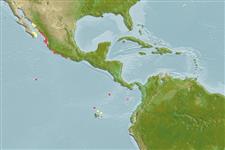>
Blenniiformes (Blennies) >
Tripterygiidae (Triplefin blennies) > Tripterygiinae
Etymology: Axoclinus: Greek, axis = axis + Greek, klinein = sloping and bed, due to the four apophyses of sphenoid bone.
Environment: milieu / climate zone / depth range / distribution range
Ekologi
laut dasar (demersal); kisaran kedalaman 7 - 8 m (Ref. 46206). Tropical
Eastern Central Pacific: Isla del Coco. A very similar but possibly undescribed species from the Revillagigedo Islands.
Size / Weight / umur
Maturity: Lm ? range ? - ? cm
Max length : 3.5 cm TL jantan/; (Ref. 11482)
deskripsi pendek
Morfologi | Morfometrik
Duri punggung (Keseluruhan (total)): 16; duri punggung lunak (Keseluruhan (total)): 9; Duri dubur 2; Sirip dubur lunak: 18. Lateral line gradually descending from upper edge of gill cover to midlateral axis; lateral line with 21-26 tubed scales followed by 8-12 notched scales; total scales in longitudinal series 33-35; a small lanceolate cirrus on upper edge of eye. Head pink to reddish; side with 3 broad, dark brown bars with narrow, whitish spaces between them; a black band around base of caudal fin; caudal fin frequently black (Ref. 11482).
Adults inhabit shallow rocky areas. They feed on tiny invertebrates and algae (Ref. 11482). Eggs are hemispherical and covered with numerous sticky threads that anchor them in the algae on the nesting sites (Ref. 240). Larvae are planktonic which occur primarily in shallow, nearshore waters (Ref. 94114).
Fricke, R., 1997. Tripterygiid fishes of the western and central Pacific, with descriptions of 15 new species, including an annotated checklist of world Tripterygiidae (Teleostei). Theses Zool. 29:1-607. (Ref. 27223)
Status IUCN Red List (Ref. 130435)
ancaman kepada manusia
Harmless
penggunaan manusia
informasi lanjut
Umur / SaizPertumbuhanpanjang-beratpanjang-panjangukuran frekuensiMorfometrikMorfologiLarvaDinamika larvapemulihanKelimpahanBRUVS
AcuanBudidaya airprofil budidaya airStrainGenetikaElectrophoresesDiturunkanPenyakit-penyakitPengolahanNutrientsMass conversion
mitraGambarStamps, Coins Misc.Suara-suaraCiguateraKecepatanTipe renangArea insangOtolithsOtakPenglihatan / visi
Alat, peralatan
laporan khas
muat turun XML
Sumber internet
Estimates based on models
Preferred temperature (Ref.
123201): 24.8 - 29.1, mean 28 °C (based on 105 cells).
Phylogenetic diversity index (Ref.
82804): PD
50 = 0.5156 [Uniqueness, from 0.5 = low to 2.0 = high].
Bayesian length-weight: a=0.00562 (0.00258 - 0.01228), b=3.08 (2.89 - 3.27), in cm total length, based on LWR estimates for this (Sub)family-body shape (Ref.
93245).
Trophic level (Ref.
69278): 2.8 ±0.26 se; based on food items.
Daya lenting (Ref.
120179): Tinggi, Waktu penggandaan populasi minimum kurang dari 15 bulan (Preliminary K or Fecundity.).
Fishing Vulnerability (Ref.
59153): Low vulnerability (10 of 100).
